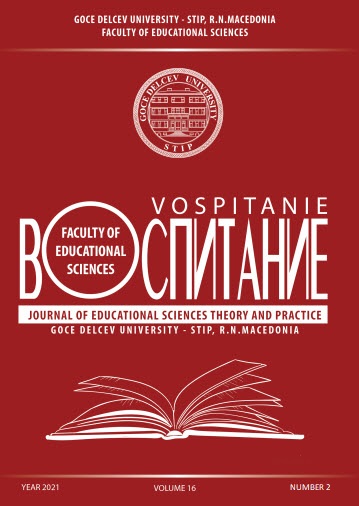THE ROLE OF THE TEACHER IN IDENFIYING THE TALENTED AND GIFTED CHILDREN
Abstract
Nowadays, the issue of identifying, developing and supporting the talented and gifted children is of paramount importance. Educational institutions and in particular teachers and parents are responsible to identify the advantages and the capabilities that a child has developed over the time and in the same time to work further in advancing those talents to a higher level. Identification and development of the talents is important not only for a talented child but for the entire society. The educational policies should be oriented in the development of talents enabling the schools and teachers to organize different events with the sole intention, developing the talents. Talented and gifted children are the potential for development for every country. The elementary school teachers should work closely with school professionals, physiologists and parents in regards to the talents of his class. If the talents and the potential is not identified the same cannot be further developed. Therefore, it is the duty of the teacher to follow and monitor every child and identify the characteristics that differ one child from the other.Talented and gifted children have identifiable attributes including unusual vigilance, early fast learning, high language abilities, academical advantage and higher capacity of knowledge. The objective of the study is that through the empirical research to find how much are the teachers engaged in identifying the talented and gifted children. For the completion of the study will be applied the quantity approach, organized through an organized questioner with the elementary school teachers.
References
Biehler, F. Robert&J. Snowman. (2004). Psikologjia e zbatuar në mësimdhënie. Tiranë: ISP.
Dowdall, C. B.&Colangelo, N. (1982). Underachieving gifted students: Review and implications. Gifted Child Quarterly, 179-184.
Erden, G., I. Yiğit, C. Çelik&M. Guzey. (2020). The diagnostic utility of the Wechsler Intelligence Scale for Children-Fourth Edition (WISC-IV) in identification of gifted children. The Journal of General Psychology, 1-20.
Fraiser, M. M. et al. (1995). Educators’ perception of barriers to the identification of gifted children from economically disadvantaged and limited English proficient backgrounds. Washington, DC.: National Research Center on the Gifted and Talented, Storrs, CT.
Gallagher, J. (2008). Psychology, psychologists, and gifted students . Në In S. I. Pfeiffer (Ed.), Handbook of giftedness in children (fv. 1-12). New York: NY: Springer.
Karnes, M. B. & L. J. Johnson . (1991). The Preschool/Primary Gifted Child. Journal for the Education of the Gifted, 267-283.
Kuo CC, Maker J, Su FL and Hu C. (2010). Identifying young talented children and cultivatingproblem solving abilities and multiple intelligences. Learning and Individual Differences , 365–379.
Lohman, D. F., & Lakin, J. M. (2011). Intelligence and reasoning. Në I. R. (Eds.), The Cambridge handbook of intelligence (fv. 419-441). New York: NY: Cambridge University Press.
Marland, S. P. (1972). Education of the Gifted and Talented: Report to the Congress of the United States by the U.S. Commissioner of Education and Background Papers Submitted to the U.S. Office of Education. Washington: Washington, DC: U.S. Government Pr.
MASHT. (2019). Udhëzim Administrativ dhe udhëzuesi për fëmijët/nxënësit me aftësi të jashtëzakonshme , dhunti dhe talente. Prishtinë: MASHT.
Miranda, L. C. (2013). Identification of gifted students by teachers: reliability and validity of the cognitive abilities and learning scale. Revista de Investigación y Divulgación en Psicología y Logopedia , 14-18 .
Okoye, M. D. (2013). Roles of Parents and Teachers in the Identification and Development of Gifted/Talented Students,. Academic Journal of Interdisciplinary Studies, 25-35.
Prieto, L., J., Parra, C., Ferrándiz and C. Sánchez. (2004). The role of the teacher within the identification of gifted students.
Prieto, M. D. et al. (2006). creative abilities in earlychildhood. Journal of Early Childhood Research, 277-290.
Renzulli, J. S. (2012). Reexamining the Role of Gifted Education and Talent Development for the 21st Century: A Four-Part Theoretical Approach. National Association for Gifted Children, 150-159.
Ross, P. O. (1993). National Excellence: A Case for Developing America's Talent. Washington: US Department OF Education.
Siegle, D., & Powell, T. (2004). Exploring teacher biases when nominating students for gifted programs. . Gifted Child Quarterly, 21–29.
Subotnik, R.F., Olszewski-Kubilius, P., Worrell, F.C. (2011). Rethinking giftedness and gifted education: A proposed direction forward based on psychological science. Psychol. Sci. Public Interest, 3–54.
World Council for Gifted and Talented Children. (2021). Global principles for professional learning in gifted education. World Council for Gifted and Talented Children. https:// world-gifted.org/professional-learning-global-principles.pdf.
Copyright (c) 2021 Воспитание / Vospitanie - Journal of Educational Sciences, Theory and Practice

This work is licensed under a Creative Commons Attribution 4.0 International License.







